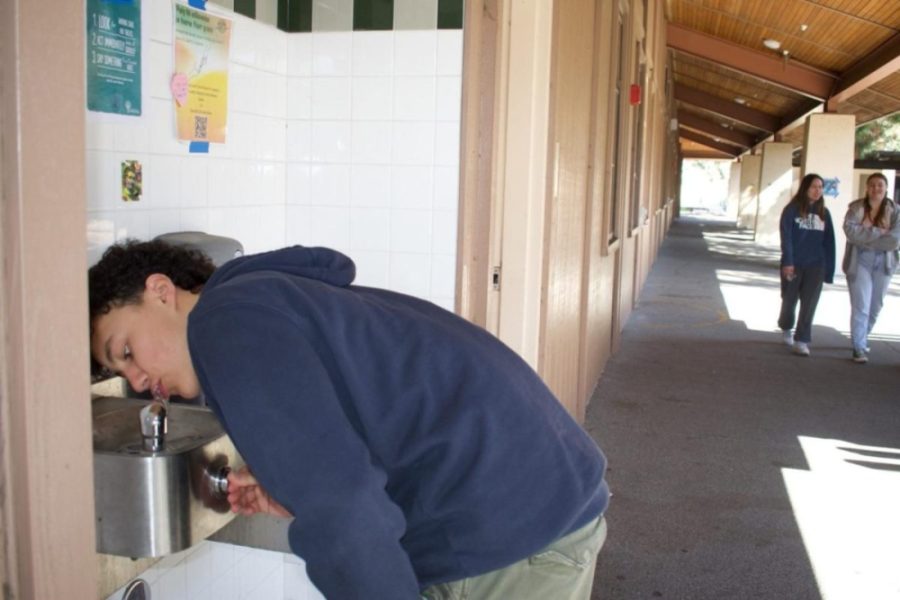Bill aims to assure safety of school drinking water
Sophomore Jacob Kinsky drinks water from one of Palo Alto High School’s water fountains. Kinsky said he is not concerned about the quality of Paly’s water. “I get thirsty a lot and I like to drink water but I don’t really know very much about lead poisoning and how that problem works,” Kinsky said. “I don’t really notice anything and I feel like the water is perfectly fine as is.” According to previous testing from 2018, Paly’s lead levels have all been reported to be under five ppb.
May 16, 2023
A bill that would mandate stricter standards for lead in water at public California schools is working its way through the California State Assembly, with a hearing Thursday in Sacramento.
The bill, A.B. 249, was introduced on Jan. 18 by California Assemblyman Chris Holden. In contrast to the current mandate that demands lead levels in water be under 15 parts per billion, the bill would lower the standard to under five parts per billion. It would require schools to test every water tap and take action for any tap over the new limit. The bill was heard and passed by two committees already. If it passes out of committee Thursday and gets approved by the Assembly, it will move on to the Senate and then possibly the governor’s signature.
Currently, lead testing has covered only a few taps at schools and remediation was only required if water tested over 15 parts ppb, which was originally set as a corrosion control standard.
Christina Hecht, Senior Policy Advisor of Nutrition Policy Institute, at the University of California Division of Agriculture and Natural Resources, said lead can be threatening to child health, as it can damage body systems, slow growth and harm development.
“Children, particularly those under age six, are more vulnerable to lead because of their higher gastrointestinal absorption and because they ingest, drink and breathe more per body weight,” Hecht said. “Also, the plasticity of the young brain makes it more susceptible to damage and lowered IQ and behavior problems can result from lead exposure.”
According to Hecht, a requirement of under five ppb would be a more health-based regulation to ensure water quality and student health.
“I would say that five is closer to a health-based level and that’s what we’d like to see rather than 15 which was more of an operational level for water utilities’ corrosion control,” Hecht said.
The bill would require that every tap used for drinking or cooking be tested once over the course of five years. It would also mandate the state water board to reserve funds from the federal Infrastructure Investment and Jobs Act (also known as the Bipartisan Infrastructure Law) of 2021 to cover the cost of testing as well as remediation of taps found to emit water over the level.
“That’s a really noteworthy part of this bill because a lot of states have bills to do testing of one sort or another,” Hecht said. “It’s extremely rare that they also include money to fix the problem.”
According to Eric Holm, the director of facilities and construction at Palo Alto Unified School District, if A.B. 249 were to pass, schools testing over five ppb would have to determine where the lead was coming from, notify parents and guardians, and take instant action to shut down the faucet and fix the problem.
“The process is to take water samples and have a lab test the water quality,” Holm said. “If a fountain is too high then the fountain is taken out of service immediately, replaced, and retested after the fixture is replaced.”
Lead in water can be caused by a variety of factors which include old pipes and joints, Holm said. Lead can only enter water if there is lead in the building’s plumbing parts and water sits long enough for lead to leach into it.
“Older fixtures sometimes have lead components in them or the pipes could have lead from solder joints that fail,” Holm said.
According to Hecht, many schools have found that lead in water is usually solvable by fixing the fountain rather than fixing piping within the building.
“If you change out the water fountain, you are most likely to solve the problem right there,” Hecht said.
Palo Alto High School principal Brent Kline said many of the pipes in the renovation of the Tower Building have been replaced, which would help prevent further lead from entering water at Paly.
“I took a tour of the Tower Building, all the pipes — its very old and fascinating inside there actually, but all the pipes have been replaced,” Kline said.
In response to the bill, Kline said the bill would be a good way to help guarantee safe and reliable water in schools.
“I think that moving towards a safe and healthy water source for all of us is absolutely important,” Kline said. “I would always lean towards a more restrictive law in this area.”
Similarly, sophomore Hanu Thakur said the bill would acknowledge the safety of students and children.
“I think California should pass this bill because having a toxic substance in a water system that kids digest can have fatal effects,” Thakur said.
Based on previous testing from 2018, Paly has had stable lead levels all below five ppb, but other schools in the Bay Area have had higher, more-worrisome levels. Out of 18 schools in Palo Alto, two schools were found to contain water with lead over five ppb affecting five taps across the schools. According to the 2018 testing, highest lead levels were at Addison Elementary School, prior to further action, with two fountains testing at 62 ppb and 24 ppb.
In reaction to the testing results from 2018, Thakur said the information was surprising and disturbing.
“This information alarms me because I thought Palo Alto water was relatively clean,” Thakur said. “I think students should have access to clean water because it is needed for humans to survive and even if it is a hassle to remove and change the pipes, I think we should change the system so that everyone has access to clean water.”
Junior Bella Nguyen said that the bill should be passed because clean water is a necessity.
“I think it [clean water] is worth spending the money so we don’t compromise the student body’s health, and I think the students’ health is more important than the money so that sacrifice is necessary,” Nguyen said.
According to Hecht, addressing higher lead levels in schools, like Addison’s previous higher numbers, would be more important to fix first.
“It’s really important to get rid of the highest lead levels first,” Hecht said. “We need to see which schools have higher levels, like the school that had 62, and I’d be way more concerned about dealing with that than the school that has 13.”
Hecht said the bill would be helpful in lowering the highest levels for schools in Palo Alto.
Kline said he usually drinks water that he brings from home, but the bill would increase his confidence about school water. When asked if the bill would make him more inclined to drink school water, Kline said yes.
“I hope it [the water] is safe and that people are doing what they are supposed to be doing when they test our water,” Kline said. “I’m hoping that happens to ensure we have quality drinking water and I think that it’s gonna be a growing concern not just here at our school but worldwide.”










![A protester in a chicken suit wearing a taco hat with the words “Cluck Trump” at the “No Kings” Democracy Fair in Palo Alto on Saturday. Protestor Mary Chan said she and her husband are horrified at the state of science and medicine in America. “What he [Trump] is doing by defunding scientific research is destroying our academic medical centers, and he’s [Trump] bankrupting rural medical centers,” Chan said. “We will have lasting negative impacts on American health for decades.”](https://palyvoice.com/wp-content/uploads/2025/10/11562FFE-9912-4152-BB01-582426B52ECB_1_105_c-225x300.jpeg)